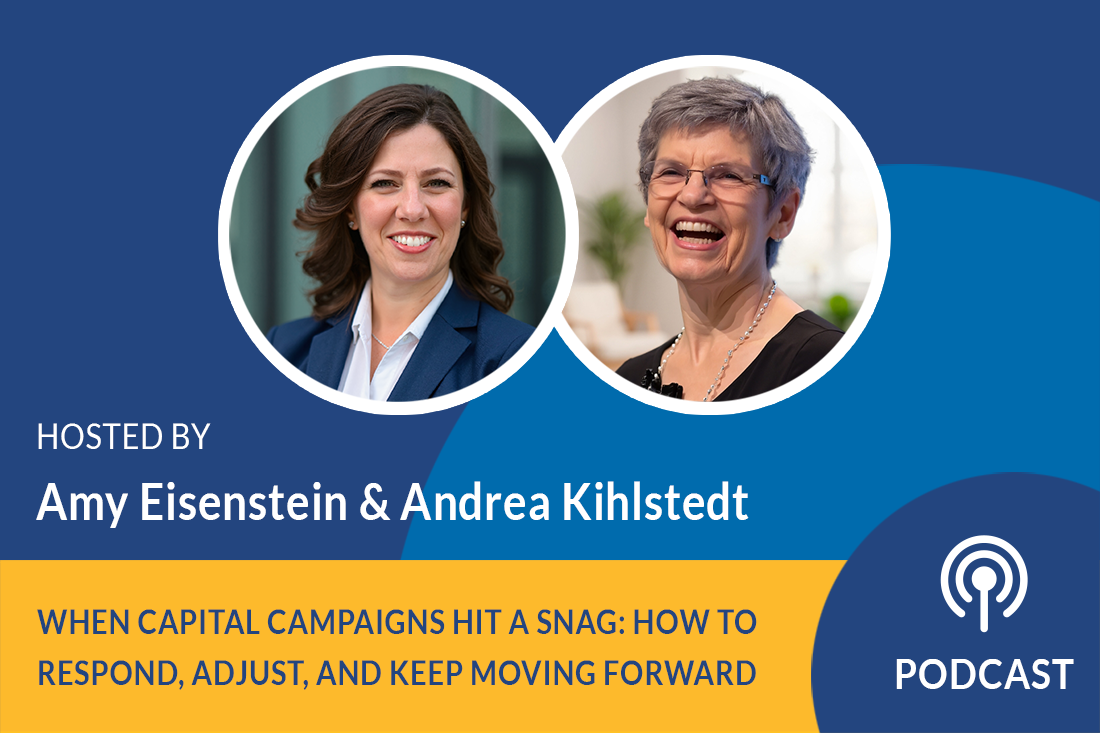Podcast: How to Create a Behind the Scenes Power Team

Season 3, Episode 3
In this episode, campaign experts Amy Eisenstein and Andrea Kihlstedt discuss why it matters that your board chair, executive director, and development director are the real power team for your campaign and they share some thoughts about how to get them working together well.
Listen Now:
Amy Eisenstein:
Where is the real power in your campaign? In other words, who calls the shots and makes the decisions? That’s what we’re going to talk about in today’s episode.
Hi, I’m Amy Eisenstein. I’m here with my co-founder, Andrea Kihlstedt, and we’re super excited to be talking to you about the real power center of your capital campaign. Andrea, why don’t you get us started?
Andrea Kihlstedt:
Hi there. Amy, this is such a great topic. I’m so happy we’re talking about it. I don’t think anybody talks well about this topic. In all the campaigns I’ve done over all these years, I don’t think I’ve ever seen it done in a way that I think is right.
Creating a “Power Team” for Your Capital Campaign
Let me talk about the problem. So where is the power?
- Is the power with your board chair?
- Is the power with your executive director?
- Is the power with your development director?
- Is the power with the campaign chair?
- Who makes the decisions when key decisions need to be made?
That [last question] is a really interesting question because all of those people have sway over different groups. Your board chair has sway, of course, over the board, and there are a lot of things that come up at the board level regarding a capital campaign. The executive director has to be informing and paying attention to the entire staff and to the larger organizational budget.
The development director, of course, is worrying about the fundraising part, the actual organizing and managing of the campaign itself. And if there’s a campaign chair — which, at some point you will have a campaign chair — the campaign chair is supposedly watching over the campaign, right? But who actually, when a problem comes up, who’s going to say:
Well, this is what we should do.
I think that you, as people doing campaigns, should think carefully about this. And one of the ways that we think you should move forward is to pull that group together, to actually create a behind the scenes power group of those players so that they think of themselves as a team and they have a way or ways of being in regular touch with one another about the campaign, so that they can see the campaign from the various different perspectives, make decisions and know whose job it is to do what in these high level decisions that are made.
Amy Eisenstein:
Yeah.
Andrea Kihlstedt:
Does that make sense, Amy?
Amy Eisenstein:
Yeah, I think it does. So instead of initially thinking about a whole campaign committee, which is where a lot of organizational leaders go to, who should be on our campaign committee, and then they want to put every person they know onto this enormous umbrella campaign committee.
So we’re talking about really the smallest and the most nimble of the core teams, the kitchen cabinet, but we’re calling it the power team. Really just of the development director, the executive director, the board chair, and the campaign chair (when you have one), because at the heart of the campaign, those are the decision makers. That’s the power center, and we want to talk about the process to not only put that team together — get them rowing in the same direction, make sure that they have a process and a system for coming to consensus when there’s disagreement — because you really need to present a united front and communicate regularly, otherwise it’s going to trip up your campaign.
Andrea Kihlstedt:
Yeah, it’s so important. Thinking about the campaign steering committee, the campaign steering committee is not a decision-making body. You can’t go to the campaign steering committee with a big question, just throw it on the table. These people don’t have immediate information available to make big decisions.
So even questions like, well, what should be on the agenda of the campaign steering committee, need to come from someone. Whose job is it to figure out those agendas and how to drive those meetings so they end up being effective?
Encouraging Your Power Team to Work Well Together
So always, we’re looking to a very few people to be the decision makers and the people who are chewing over issues throughout the campaign, and I think it makes very good sense to have these power brokers come together. We put out a question to our experts at Capital Campaign Pro about how they would think about this, and we got some really interesting suggestions.
One from one of our advisors, Xan, she said:
I think you should spend time, when you get a group like this small group like this together, of helping them get to know one another. Not just of saying, well, let’s talk about the campaign, but realize that these people often don’t know one another well.
The board chair, the executive director and the development director, or whoever’s heading up development, don’t know one another well. So Xan’s suggestion is that you get them together and you do things like, for example, have them take the Asking Styles Assessment at askingmatters.com.
You have them talk about what their dreams and desires are for this campaign or the organization, or why they’re so involved in the organization. That you really have them start with conversations that are not specific and tactical, but are icebreakers. Realizing that these people are going to work together for the duration of what probably will be a three-year campaign, maybe longer, so you need to give them an opportunity to get to know one another and understand how each of them functions. You want them to feel like they’re buddies in making this happen.
Amy Eisenstein:
Right. I think, you could even get down to basics. There may be a organizational culture of communicating by email, but your board chair at work may communicate by Slack or text or something else. So you might go around to this very intimate committee and say:
You know what? We’re going to be communicating a lot over the next two to three years. What’s the best and most efficient, most effective way for us to communicate and make decisions?
These Are Your Key Decision Makers
I think that there are a lot of decisions to be made. Sometimes there’s time to think about it and discuss it. Sometimes there’s not. And so in those instances, what should we do? Are we going to hop on Zoom? Are we going to have a group call on FaceTime or what… Sometimes it’s tactical, but very practical ways of figuring out how people like to communicate.
And when we do disagree, what’s going to happen? What’s the process? Who’s the tiebreaker? How do these things, how do we make decisions?
Andrea Kihlstedt:
You could imagine that something happens with a campaign, maybe you get an unexpected big gift that changes the whole trajectory of the campaign. So this group is going to have to figure out what to do about that with regard to the campaign, with regard to the board, with regard to the organization, and planning that the organization might have to do. All of a sudden a lot of things need to happen if with a spectacular big gift or if you miss a big gift, a big gift looks like isn’t going to come in. That million dollar gift you expected at the top of your campaign, the person says no. Well, you have to have the leaders talking to one another and being in agreement about the best way to function with either setbacks or set forwards, is that the way to?
Amy Eisenstein:
Yeah, I think —
Andrea Kihlstedt:
Set forward, when something goes good and a setback when something goes bad? I don’t know.
Communication Between Your Power Team is a Must
Amy Eisenstein:
I’ve never heard of set forward before, but I like it. But I think that the issue is communicating because you don’t want to show up at a board meeting and the board chair doesn’t know you didn’t get the big gift, or that they don’t know that you did get the big gift. I mean, you want to make sure that your board chair and your campaign chair are fully in the loop, so as they’re out talking to people about the campaign, they don’t look foolish. You don’t want to be on different pages.
And so I think another good example of when a decision needs to be made by this very small group is when and how to solicit the board. Somebody needs to make that decision, and this power team is probably the one to do it. You’re right, it’s not going to be made by a bigger committee down the road, but the initial planning, the timing, the budget is going to be made primarily in this very small group setting.
Informing Your Program Staff
Andrea Kihlstedt:
Another thing that comes up in organizations, and we don’t think about it enough, but that would emanate from a small group like this, is when do you start informing all of the program staff? The program staff play an important role in the campaign because they are often the people at the frontline talking to the folks that you’re serving, talking to donors who may come in or donor’s families who may come in and be served.
So the program staff needs to understand what the campaign is about, and the timing of doing that and how that is done is actually an interesting and complicated question that needs to be made in a way that is informed by the campaign, is informed by the executive director, who is over the entire staff, and is informed by the board as well, so that the board knows and understands how the full staff is going to be involved in the campaign. That’s a great topic for this power team to wrangle with.
Amy Eisenstein:
Yeah, I love this concept of the power team and we often read articles about the campaign committee and all of its various forms and functions, but I don’t think we’ve ever thought about it from this really nuclear behind the scenes power team and that they are the driving force of the campaign.
So next steps for listeners, hopefully you’re starting to think about your campaign or maybe your mid-campaign, figure out:
- How does this power team communicate function?
- What is the cadence of the meetings? Are they meeting weekly? Are you meeting monthly?
- How are you communicating between meetings?
- Who sets the agenda? Who is driving that?
- Who is the manager of this particular power team? Is it the executive director or the development director who calls those meetings? Is it the board chair?
Andrea Kihlstedt:
Somebody’s probably a staff person who’s responsible for calling those meetings and following up, but somebody needs to do it so they don’t just fall off everybody’s radar.
Amy Eisenstein:
Excellent. I love when we come up with new ideas. I mean, it’s not novel and it’s not… But just framing it in a way that people should really think about how do we think about this core nuclear team.
Andrea Kihlstedt:
How to pull that together and the fact that you should pull it together and they should be talking to one another about what their roles are going to be individually and collectively when it comes to the campaign.
Amy Eisenstein:
Yeah.
Final Thoughts
Andrea Kihlstedt:
This campaign is such a big deal. All of a sudden the organization is heading down this road of raising multiple times whatever they’ve raised before, and we don’t put the structures together to make that happen effectively. This is the first, or one of the first structures might really work.
Amy Eisenstein:
Yeah, I think it’s about not taking each other for granted, not making the assumption that your board chair can or wants to show up for a weekly meeting.
- Can you do this virtually?
- How should you be connecting?
- What’s the time commitment and limit that they have?
- And what’s the best way to conduct these decisions that are going to drive the campaign?
So I love it. Great conversation today, Andrea.
Andrea Kihlstedt:
Thanks Amy.
Amy Eisenstein:
All right, we’ll see you next time. Thanks for joining us.



Leave a Comment